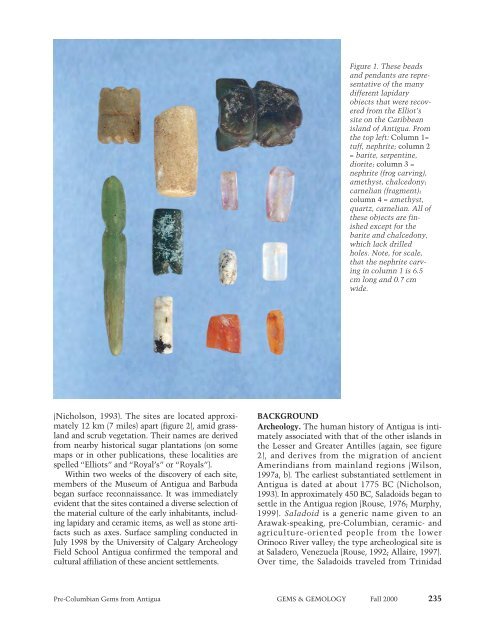Fall 2000 Gems & Gemology - Gemfrance
Fall 2000 Gems & Gemology - Gemfrance
Fall 2000 Gems & Gemology - Gemfrance
You also want an ePaper? Increase the reach of your titles
YUMPU automatically turns print PDFs into web optimized ePapers that Google loves.
(Nicholson, 1993). The sites are located approximately<br />
12 km (7 miles) apart (figure 2), amid grassland<br />
and scrub vegetation. Their names are derived<br />
from nearby historical sugar plantations (on some<br />
maps or in other publications, these localities are<br />
spelled “Elliots” and “Royal’s” or “Royals”).<br />
Within two weeks of the discovery of each site,<br />
members of the Museum of Antigua and Barbuda<br />
began surface reconnaissance. It was immediately<br />
evident that the sites contained a diverse selection of<br />
the material culture of the early inhabitants, including<br />
lapidary and ceramic items, as well as stone artifacts<br />
such as axes. Surface sampling conducted in<br />
July 1998 by the University of Calgary Archeology<br />
Field School Antigua confirmed the temporal and<br />
cultural affiliation of these ancient settlements.<br />
Figure 1. These beads<br />
and pendants are representative<br />
of the many<br />
different lapidary<br />
objects that were recovered<br />
from the Elliot’s<br />
site on the Caribbean<br />
island of Antigua. From<br />
the top left: Column 1=<br />
tuff, nephrite; column 2<br />
= barite, serpentine,<br />
diorite; column 3 =<br />
nephrite (frog carving),<br />
amethyst, chalcedony;<br />
carnelian (fragment);<br />
column 4 = amethyst,<br />
quartz, carnelian. All of<br />
these objects are finished<br />
except for the<br />
barite and chalcedony,<br />
which lack drilled<br />
holes. Note, for scale,<br />
that the nephrite carving<br />
in column 1 is 6.5<br />
cm long and 0.7 cm<br />
wide.<br />
BACKGROUND<br />
Archeology. The human history of Antigua is intimately<br />
associated with that of the other islands in<br />
the Lesser and Greater Antilles (again, see figure<br />
2), and derives from the migration of ancient<br />
Amerindians from mainland regions (Wilson,<br />
1997a, b). The earliest substantiated settlement in<br />
Antigua is dated at about 1775 BC (Nicholson,<br />
1993). In approximately 450 BC, Saladoids began to<br />
settle in the Antigua region (Rouse, 1976; Murphy,<br />
1999). Saladoid is a generic name given to an<br />
Arawak-speaking, pre-Columbian, ceramic- and<br />
agriculture-oriented people from the lower<br />
Orinoco River valley; the type archeological site is<br />
at Saladero, Venezuela (Rouse, 1992; Allaire, 1997).<br />
Over time, the Saladoids traveled from Trinidad<br />
Pre-Columbian <strong>Gems</strong> from Antigua GEMS & GEMOLOGY <strong>Fall</strong> <strong>2000</strong> 235


